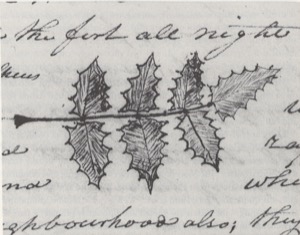February 12, 1806
[Lewis]
This morning we were visited by a Clatsop man who brought with him three dogs as a remuneration for the Elk which him self and nation had stolen from us some little time since, how ever the dogs took the alarm and ran off; we suffered him to remain in the fort all night.
There are two species of ever green shrubs which I first met with at the grand rappids of the Columbia and which I have since found in this neighbourhood also; they grow in rich dry ground not far usually from some watercourse. the roots of both species are creeping and celindric. the stem of the 1st [1] is from a foot to 18 inches high and as large as a goosqull; it is simple unbranced and erect. it's leaves are cauline, compound and spreading. the leafets are jointed and oppositely pinnate, 3 pare & terminating in one, sessile, widest at the base and tapering to an accuminated point, an inch and a quarter the greatest width, and 3 inches & a ¼ in length. each point of their crenate margins armed with a subulate thorn or spine and are from 13 to 17 in number. they are also veined, glossy, carinated and wrinkled; their points obliquely pointing towards the extremity of the common footstalk.— The stem of the 2nd [2] is procumbent abot the size of the former, jointed and unbranched. it's leaves are cauline, compound and oppositely pinnate; the rib from 14 to 16 inches long celindric and smooth. the leafets 2½ inches long and 1 inch wide. greatest width ½ inch from their base, to which they are regularly rounded, and from the same point tapering to an accute apex, wich is mostly, but not invariably tirminated with a small subulate thorn. they are jointed and oppositely pinnate, consisting of 6 pare and terminating in one, sessile serrate, or like the teeth of a whipsaw, each point terminating in a small subulate spine, being from 25 to 27 in number; veined, smooth, plane and of a deep green, their points tending obliquely towards the extremity of the rib or common footstalk. I do not know the fruit or flower of either. the 1st resembles the plant common to many parts of the U' States called the mountain holley.
[Clark]
This morning we were visited by a Clatsop man who brought with him three dogs as a remuneration for the Elk which himself and Nation had Stolen from us Some little time Sence, however the dogs took the alarm and ran off; we suffered him to remain in the fort all night.
There are two Species of evergreen Shrubs. this is the leaf of one [3] which I first met with at the grand rapids of the Columbia River, and which I have sence found in this neighbourhood also; they usially grow in rich dry ground not far from Some water course. the roots of both Species are creeping and celindric. the Stem of the first (as above) is from a foot to 18 inches high and as large as a Goose quil; it is Simple and erect. its leaves are cauline, and Spredding. the leafits are jointed & oppositly poinnate 3 par and termonateing in one, cessile widest at the base and tapering to an accuminated point, an inch and ¼ the greatest width; & 3¼ inches in length. each point of their crenate margins armed with a thorn or Spine, and are from 13 to 17 in number. they are also veined, glossy, corinated and wrinkled; their points obliquely pointing towards the extremity of the Common footstalk.
The Stem of the 2nd is procumbent about the Size of the former, jointed and umbracated. it's leaves are Cauline, compound and oppositly pointed; the rib from 14 to 16 inches long Celendric and Smooth the leafits 2½ inches long and 1 inch wide. the greatest width ½ inch from their base which they are regularly rounded, and from the Same point tapering to an accute apex, which is mostly but not entirely termonated with a Small Subulate thorn. they are jointed & oppositly pointed consisting of 6 par and termonateing in one (in this form) [4] sessile, Serrate, or like the teeth of a whipsaw, each point terminateing in a small subulate spine, being from 25 to 27 in numbr; veined, Smoth, plane and of a deep green, their points tending obliquely towards the extremity of the rib or common footstalk. I do not know the fruit or flower of either. the 1st resembles a plant Common to maney parts of the United States Called the Mountain Holly—.
[Ordway]
Wednesday 12th Feby. 1806. continues raining. one of the Clotsop Indians came to the Fort and Stayed all night.—
[Whitehouse]
Wednesday Febry 12th This day was rainey & wet, An Indian came to our fort & staid during last night; this Indian sold one of our Men a Sea otter skin. He left us this morning well pleased with the Sale he had made.—




